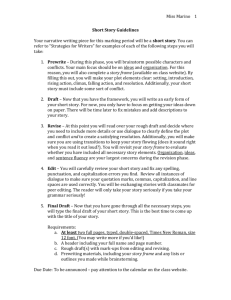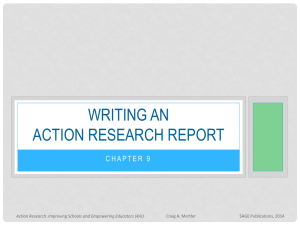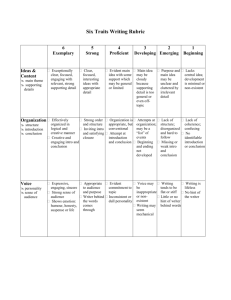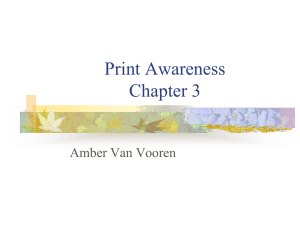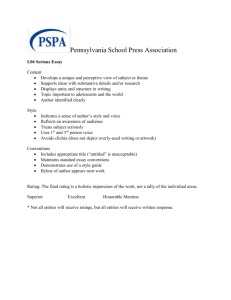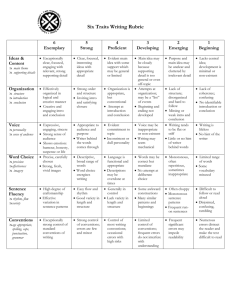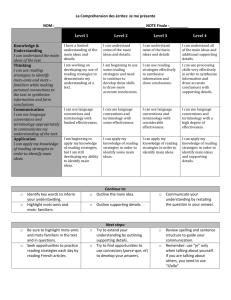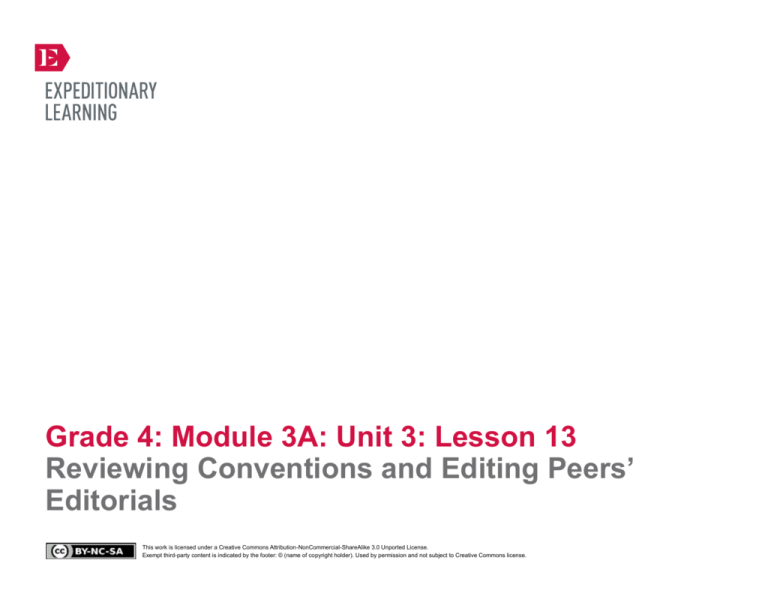
Grade 4: Module 3A: Unit 3: Lesson 13
Reviewing Conventions and Editing Peers’
Editorials
This work is licensed under a Creative Commons Attribution-NonCommercial-ShareAlike 3.0 Unported License.
Exempt third-party content is indicated by the footer: © (name of copyright holder). Used by permission and not subject to Creative Commons license.
GRADE 4: MODULE 3A: UNIT 3: LESSON 13
Reviewing Conventions and Editing Peers’ Editorials
Long-Term Targets Addressed (Based on NYSP12 ELA CCLS)
I can write an opinion piece that supports a point of view with reasons and information. (W.4.1)
I can use the writing process to produce clear and coherent writing (with support). (W.4.5)
I can use conventions to send a clear message to my reader. (L.4.1, L.4.2, L.4.3)
Supporting Learning Targets
Ongoing Assessment
• I can check my peers’ work for correct capitalization.
• Conventions anchor charts
• I can check my peers’ work for correct spelling.
• I can check my peers’ work for correct punctuation at the end of sentences.
• Simple Machine Editorials (second drafts annotated for
edits)
• I can check my peers’ work for complete sentences.
• Exit tickets
Copyright © 2013 by Expeditionary Learning, New York, NY. All Rights Reserved.
NYS Common Core ELA Curriculum • G4:M3A:U3:L13 • June 2014 •
1
GRADE 4: MODULE 3A: UNIT 3: LESSON 13
Reviewing Conventions and Editing Peers’ Editorials
Agenda
Teaching Notes
1. Opening
• This lesson is very similar to the editing lesson in Module 2A (Unit 3, Lesson 14).
A. Engaging the Writer (2 minutes)
B. Reviewing Learning Targets (3 minutes)
2. Work Time
A. Chalk Talk (15 minutes)
B. Modeling: Editing for Conventions (5 minutes)
C. Editing Stations (25 minutes)
3. Closing and Assessment
A. Exit Ticket (5 minutes)
B. Completing Our Simple Machines Editorial Rubric
(5 minutes)
4. Homework
A. Continue reading in your independent reading book
for this unit at home.
• In this lesson, students read one another’s editorials to identify issues with writing conventions
(spelling, punctuation, capitalization, and use of complete sentences). Students just note mistakes as
they edit; they do not actually correct the errors. In the next lesson (Lesson 14), students will be given
time to correct their own work.
• Given the one-hour time constraint, language standards are not heavily emphasized in these modules.
Students need additional instruction on language conventions during other parts of the school day. This
lesson is intended to review and reinforce that additional instruction, and help students apply the
conventions to their own authentic product.
• In advance: Write a short “convention-less paragraph” with dialogue without proper conventions—
incorrect spelling, lack of punctuation, and no capitalization—to display on an overhead or with a
document camera.
• Set up four stations with Convention Charts, markers, and colored pencils. Ideally each station will have
enough room for about a quarter of your class to sit. Students should be able to see Convention Charts,
access materials, and have a surface to write on (table/desks or clipboards).
• Students again use colored pencils. In this lesson, a different color is used for each type of convention
(for example, red pencils and markers for spelling, blue for punctuation, green for capitalization, and
purple for incomplete sentences).
• Having different colors at each station will help students to focus on editing for one convention at a time
and recall what must be corrected when revising. Place matching colored pencils and markers at each
station.
• Post a chart paper at each station. On each chart, write the following questions in the designated color: *
How do I make sure my SPELLING is correct?
– How do I know if I have a COMPLETE SENTENCE?
– How do I know if my ENDING PUNCTUATION is correct?
– How do I know if CAPITALIZATION in my writing is correct?
• Review: Chalk Talk protocol (see Appendix 1).
Copyright © 2013 by Expeditionary Learning, New York, NY. All Rights Reserved.
NYS Common Core ELA Curriculum • G4:M3A:U3:L13 • June 2014 •
2
GRADE 4: MODULE 3A: UNIT 3: LESSON 13
Reviewing Conventions and Editing Peers’ Editorials
Lesson Vocabulary
Materials
capitalization, punctuation,
conventions, complete sentences
(review)
• Document camera
• Convention-less paragraph (for teacher modeling)
• Four pieces of chart paper for Conventions anchor charts prepared with questions (see teaching notes above)
• Markers (several each of four different colors to match each chart; see teaching notes)
• Colored pencils (four colors with each color enough for a quarter of your class; see teaching notes)
• Index cards (3” x 5”) for exit ticket (one per student)
• Simple Machines Editorial rubric anchor chart (added to in Lesson 11)
Copyright © 2013 by Expeditionary Learning, New York, NY. All Rights Reserved.
NYS Common Core ELA Curriculum • G4:M3A:U3:L13 • June 2014 •
3
GRADE 4: MODULE 3A: UNIT 3: LESSON 13
Reviewing Conventions and Editing Peers’ Editorials
Opening
Meeting Students’ Needs
A. Engaging the Writer (2 minutes)
• Using a document camera, display your short convention-less paragraph. Ask for a volunteer to try to read it aloud.
• Allow students to discover the topic
of this lesson through trying to read
your convention-less paragraph.
This will help to engage students’
interest in editing for conventions.
• Ask the class what made reading this paragraph difficult. Listen for students to notice that the reason your paragraph was
unclear to them as readers was that there were no conventions used. Review with students that writers use conventions, or
writing rules, to make their message clear and understandable to readers.
• Remind students that they have already focused on the conventions for writing complete sentences, but today they will
review additional conventions and edit their writing so that it is clear and understandable to readers and ready for final
publication.
B. Reviewing Learning Targets (3 minutes)
• Introduce the supporting targets:
– I can check my peers’ work for correct capitalization.
– I can check my peers’ work for correct spelling.
– I can check my peers’ work for correct punctuation at the end of sentences.
– I can check my peers’ work for complete sentences.
• Tell students that they will be editing their editorials for the conventions listed in the supporting targets. Circle key words:
spelling, punctuation, capitalization, and complete sentences. Clarify the meanings of these words or targets as needed.
Copyright © 2013 by Expeditionary Learning, New York, NY. All Rights Reserved.
NYS Common Core ELA Curriculum • G4:M3A:U3:L13 • June 2014 •
4
GRADE 4: MODULE 3A: UNIT 3: LESSON 13
Reviewing Conventions and Editing Peers’ Editorials
Work Time
Meeting Students’ Needs
A. Chalk Talk (15 minutes)
• Point out the four stations to students. Read the Convention anchor chart at each station:
• Although students have experienced
this protocol before, it could still be
confusing for ELLs. Consider
reviewing the protocol with these
students ahead of time. Another way
to support students is to give them a
copy of shortened directions with
visuals to help guide them.
– How do I make sure my SPELLING is correct?
– How do I know if I have a COMPLETE SENTENCE?
– How do I know if my ENDING PUNCTUATION is correct?
– How do I know if my CAPITALIZATION is correct?
• Tell students that they will be doing a chalk talk to share their thoughts on each question. Give brief directions:
1. Go to your assigned chart first.
2. Read the question on the chart.
3. Add your thoughts on the question to the chart using the markers at the station.
4. Visit all charts to read the questions and your classmates’ answers. Decide if something is missing from a chart and, if so,
add it using the markers at that station.
5. Once you have visited every chart, sit in your seat.
• Give students time to visit each chart, read, and add their thoughts—about 10 minutes or less.
• Focus students whole group. Revisit each chart with students. (Either gather all of the charts or circulate as a class to each
chart so all students can see it.) Read a few responses from each chart, and circle or add important tips for each question.
Make sure to check for accuracy in punctuation and capitalization rules and offer helpful hints with spelling. Tell students
that they will use these convention anchor charts later this lesson.
Copyright © 2013 by Expeditionary Learning, New York, NY. All Rights Reserved.
NYS Common Core ELA Curriculum • G4:M3A:U3:L13 • June 2014 •
5
GRADE 4: MODULE 3A: UNIT 3: LESSON 13
Reviewing Conventions and Editing Peers’ Editorials
Work Time (continued)
Meeting Students’ Needs
B. Model: Editing for Conventions (5 minutes)
• Display the convention-less paragraph. Use the first few sentences of your paragraph to model. Demonstrate how to edit for
each convention by circling or underlining with the correct colored pencil (see teaching notes, above). Be sure to model
referring to the Convention anchor charts (posted at each station) as resources.
• When you model editing for
students, remember that you are
just showing them how to identify
and note mistakes, not revise them.
They will have an opportunity to
correct their mistakes in Lesson 14.
• For example: Read the capitalization chart. Read aloud your convention-less paragraph. Notice a mistake and think aloud: “I
notice that one of the rules for capitalization is to be sure names of people or places are capitalized.” Demonstrate fixing a
mistake: “I see that I capitalized ‘Machines,’ but this is not a proper noun, so it shouldn’t be capitalized. I am going to circle
it with a colored pencil from the capitalization station.”
• Clarify as needed.
C. Editing Stations (25 minutes)
• Tell students that they are going to go to all four stations to get help from peers to improve the second draft of their Simple
Machine Editorials. Divide the class into fourths to send a quarter of the students to each station, but be sure writing
partners stay together.
• Give directions:
1. Go to your assigned station with the second draft of your editorial.
2. At that station, trade papers with your peer critique partner.
3. Read your partner’s draft (with new beginning and ending) and identify any convention mistakes related to the topic of
that station’s chart.
4. When both partners are finished, move to the next station.
5. Be sure to visit all four stations.
• Circulate and confer with pairs who may need extra support. Every 5 minutes or so, remind students to rotate to another
station. Pairs that finish early can begin revising and typing, if these facilities are available. Collect students’ editorials to add
further edits. Students will use these edits to correct their spelling, punctuation, capitalization, and incomplete sentences
when they revise and publish in the next lesson.
Copyright © 2013 by Expeditionary Learning, New York, NY. All Rights Reserved.
• Be sure students are editing their
drafts with their revised
introduction and conclusion chosen
in Lessons 8 and 11.
• In addition to the Convention
anchor charts, a convention
checklist can be prepared
beforehand to support ELLs or
students with special needs during
editing.
• Consider several options if students
need more structured management
of movement. Partners can raise
their hands when they are done at a
given station and check with you
before they move on. Or students
can remain in one place, and all
materials can be available where
they are working.
NYS Common Core ELA Curriculum • G4:M3A:U3:L13 • June 2014 •
6
GRADE 4: MODULE 3A: UNIT 3: LESSON 13
Reviewing Conventions and Editing Peers’ Editorials
Meeting Students’ Needs
Closing and Assessment
A. Exit Ticket (5 minutes)
• Gather students whole group and review the learning targets. Distribute index cards (one per student). Ask students to
write their names at the top and do a “quick write” on the following questions:
* “How will this editing improve your editorials?”
* “What made editing easy or difficult for you?
• Have them share their answers with a partner, then collect the exit tickets for a formative assessment of the learning targets.
B. Completing Simple Machines Editorial Rubric (5 minutes)
• Ask students to help you add to the conventions criteria on the Simple Machines Editorial Rubric anchor chart based
on their work today.
Meeting Students’ Needs
Homework
• Continue reading in your independent reading book for this unit at home.
Note: To prepare for Lesson 14, do the following:
1. Edit students’ editorial. Remember to add only those edits that pertain to the conventions discussed in class.
2. Review the exit tickets to determine if any students need further support in the next lesson, where they will revise to
correct their mistakes and publish their editorials.
3. Type up the Simple Machines Editorial rubric anchor chart using the template in the supporting materials and make a
copy for each student.
In Lesson 14, students will finalize their writing. If they did not type up their second drafts yet, consider giving them
additional time to type their final copies before Lesson 14.
Copyright © 2013 by Expeditionary Learning, New York, NY. All Rights Reserved.
NYS Common Core ELA Curriculum • G4:M3A:U3:L13 • June 2014 •
7
Grade 4: Module 3A: Unit 3: Lesson 13
Supporting Materials
This work is licensed under a Creative Commons Attribution-NonCommercial-ShareAlike 3.0 Unported License.
Exempt third-party content is indicated by the footer: © (name of copyright holder). Used by permission and not subject to Creative Commons license.
GRADE 4: MODULE 3A: UNIT 3: LESSON 13
Convention-less Paragraph
(Sample for Teacher Reference; use this or write your own convention-less paragraph for modeling)
i am very pleesed with how my class has learned so much about Simple Machines when we first
started we new very little about Simple Machines but over the last severel weeks we hav come very far
another teacher asked how do your students know so much about how Simple Machines work and
benefit us i told her they had become expert researchers threw reading and writing
Copyright © 2013 by Expeditionary Learning, New York, NY. All Rights Reserved.
NYS Common Core ELA Curriculum • G4:M3A:U3:L13 • June 2014 •
9
GRADE 4: MODULE 3A: UNIT 3: LESSON 13
Simple Machines Editorial Rubric
A local engineering magazine wants to educate its readers on the importance of simple machines in
the age of high-tech gadgets. So they’ve decided to hold a “Campaign for Simple Machines.” Because
of your expertise on this topic, you have been asked to write an editorial describing what simple
machines are and stating your opinion on which one helps people the most in their daily lives.
Editorials will be featured in this month’s magazine.
Learning Target: I can write an editorial stating my opinion on which simple machine benefits
people the most in their everyday lives. (W.4.1)
Criteria
Meets
Partially
Meets
Does Not
Meet
Ideas
I can write an introduction in my editorial that
explains simple machines and states my opinion
clearly. (W.4.1a)
I can use scientifically accurate reasons and evidence
to support my opinion about a simple machine.
(W.4.1b)
Word Choice
I can use vocabulary from my research on simple
machines to write scientifically accurate descriptions
in my editorial. (L.4.3)
Organization
I can group together reasons with related evidence in
my editorial. (W.4.1a)
I can use linking words to connect my opinion to my
reasons. (W.4.1c)
I can develop a conclusion that summarizes my
opinion about simple machines in my editorial.
(W.4.1d)
Copyright © 2013 by Expeditionary Learning, New York, NY. All Rights Reserved.
NYS Common Core ELA Curriculum • G4:M3A:U3:L13 • June 2014 •
10
GRADE 4: MODULE 3A: UNIT 3: LESSON 13
Simple Machines Editorial Rubric
Criteria
Meets
Partially
Meets
Does Not
Meet
Conventions
I can use conventions to send a clear message to my
reader. (L.4.2)
Copyright © 2013 by Expeditionary Learning, New York, NY. All Rights Reserved.
NYS Common Core ELA Curriculum • G4:M3A:U3:L13 • June 2014 •
11

